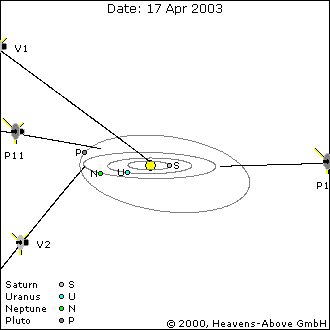
Current locations of Pioneer 10, Pioneer 11, Voyager 1, and Voyager 2 relative to the solar system (courtesy of heavens-above.com)
Where Are They Now?
After Voyager 2 completed its scan of Neptune and Voyager 1 took the first pictures of Solar System from “outside” the Solar System, the Voyager Program quickly receded from the public view. With this mission apparently complete, NASA had seemed content to let the Voyagers drift away across the stars.
And drift they did. Voyager 1 and 2 are among the fastest machines ever created by man. Voyager 1 is currently traveling at approximately 17 km/s. Voyager 2 is clipping along at the slightly slower speed of about 15 km/s. In February of 1998, Voyager 1 surpassed Pioneer 10 to become the most distant man-made object in space. Currently, Voyager 1 is about 88 times farther away from the Sun that the Earth is (see http://heavens-above.com/solar-escape.asp?/).

Current
locations of Pioneer 10, Pioneer 11, Voyager 1, and Voyager 2
relative to the solar system (courtesy of heavens-above.com)
Even NASA, however, failed to realize the reliability of the two Voyagers. The Plutonium power sources of both probes have held up stronger than NASA had planned, and are expected to provide the Voyagers with the energy they require until at least 2020. During this time, NASA plans to uses the Voyagers to find the location of the heliopause of the solar system. The heliopause is analogous to a bubble formed around the Solar System by the solar wind generated by the Sun. At some unknown distance from the Sun, the force solar wind is balanced out by the force of the galactic wind. Although no one knows the exact distance to the heliopause, most predictions put it within range of the Voyager probes within their operating lifetimes (see http://voyager.jpl.nasa.gov/mission/interstellar.html). Over forty years after their launch from Earth, the Voyager probes will still be sending data to Earth and refining and redefining the way we think about the Universe.
[Home]
[Voyager Program History] [Voyager Probe Technology] [Voyager Images] [The Golden Record] [Where Are They Now?] [Bibliography/Links]